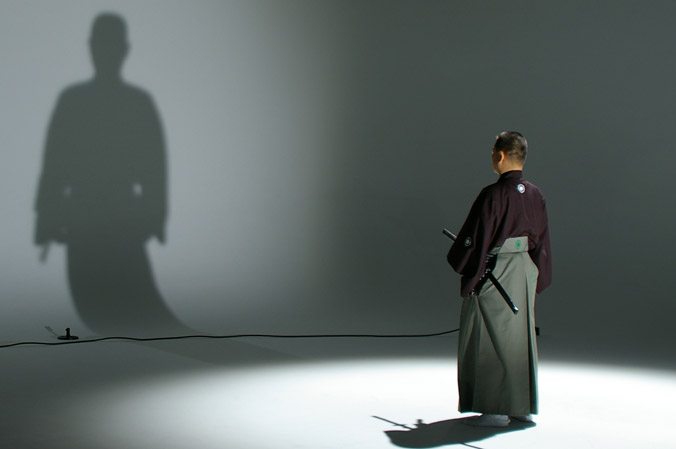Mugai Ryu Meishi Ha Soke Niina Toyoaki (Go: Gyokuso)
Born Niina Toyoaki in the city of Tsukumi in Oita prefecture on October 2, 1948 (23rd year of Showa), he began learning budo at a young age by starting with aikido. In his twenties, he found a teacher of Shinto Musoryu Jodo and Mugairyu Iaihyodo.
He subsequently began working for Mitsubishi Heavy Industries while devoting himself to budo training in the Mitsubishi Aikido Association. In 1986, he assumed Jodo and Iaido teaching duties in the Association, and in 1987, at the age of 39, he established the Tokyo Jodo Federation and set about popularizing Jodo and Iaido. In 1994, with his Iaido students as the central members, he founded the budo instruction group Suimokai, and subsequently divided Suimokai in 14 organizations. The Non Profit Organization Mugairyu was founded in 2007.
Niina Soke also devised Gyokushin Shinto-ryu, an Iaido and Kumitachi style for handicapped individuals. In 2008 he established the Mugai Ryu Foundation for which he still currently serves as the representative director. As a practitioner of Mugai Ryu Iaihyodo, he became a shihan (master instructor) in 1986, received menkyo kaiden (full transmission license) in 1996, hanshi (the highest level of master instructor) in 1998, and soke successorship in 1999. In 2004, he established Mugai Ryu Meishiha. He is also the soke of Genko-Nito-Ryu, Tosei-ryu Tanjo-jutsu and Gyokushin Shinto-ryu. He holds eigth dan hanshi in Shinto Musoryu Jodo, Uchida-ryu Tanjo-jutsu, Isshin-ryu Kusarigama-jutsu, Ikkaku-ryu Jitte-jutsu, and Chuwa-ryu Tanken-jutsu.
Unlike the other branches of Mugai Ryu, Mugai Ryu Meishiha demands actual cutting on the draw the way the samurai of historical times trained. There are three areas of training that must be sincerely pursued to be recognised as a true master of the art, kata (forms), kumitachi (paired fencing practice) and tameshigiri (test cutting). Dan rank, master certification and the traditional licenses (menkyo and menkyo kaiden) are only awarded to practitioners of the art who have mastered all three areas of study for a true understanding of the art in the manner of training undertaken by the samurai.
My Personal History and Background
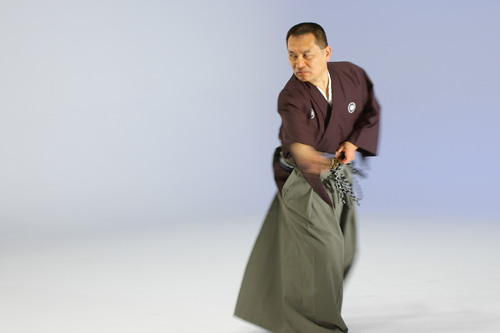
I began training in aikido, and even though bokken and jo (wooden sword and staff) are used in aikido, seeing that I was already training with the jo, I decided to start training in Shinto-muso-ryu, which specializes in jo practice.
I was told by Iwameji sensei, who was the top student (in that dojo) and my sempai, to do iaido. I think there is a fondness for Japanese swords among Japanese people.
As is written in Nitobe Inazo’s Bushido, regardless of whether or not one is conscious of a “Japanese spiritual identity”, there are still (as symbols of that identity) “swords” and “the samurai”. This is what I found in myself. Coincidentally, my jo teacher was also the head of Mugairyu, so the beginning of my study of iaido was naturally through my encounter with Mugairyu.
On Handling the Sword
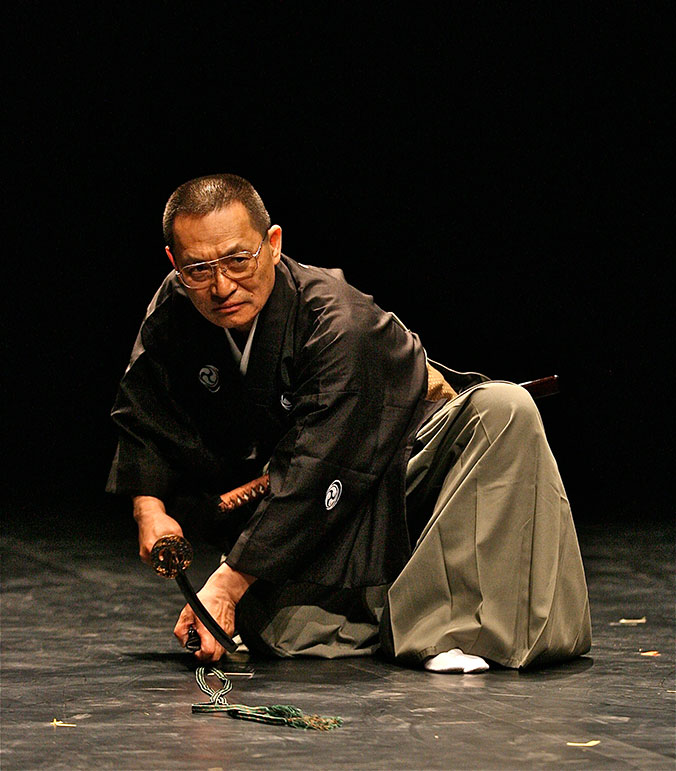
In Nitobe Inazo’s Bushido, he writes that having swords nearby during childhood engenders bushido in a person. It is necessary to be nervous around swords and understand that swords can cut, otherwise there will be no beginning to this understanding of bushido. Cutting is what makes it a Japanese sword, and I wanted to thoroughly understand, on a deeper level, what it means to “cut”. True iaido is just that, and the concepts of “cutting one another” and “the crashing together of lives (both people in the encounter are on the edge of life and death)” are prerequisites for the kata and kumitachi that have been passed down to us. I think this is uncommon in other styles of iaido and even in other branches of Mugairyu.
About Shiokawa Hosho Terushige sensei, my teacher, who passed away in March of 2014 at the age of 88.
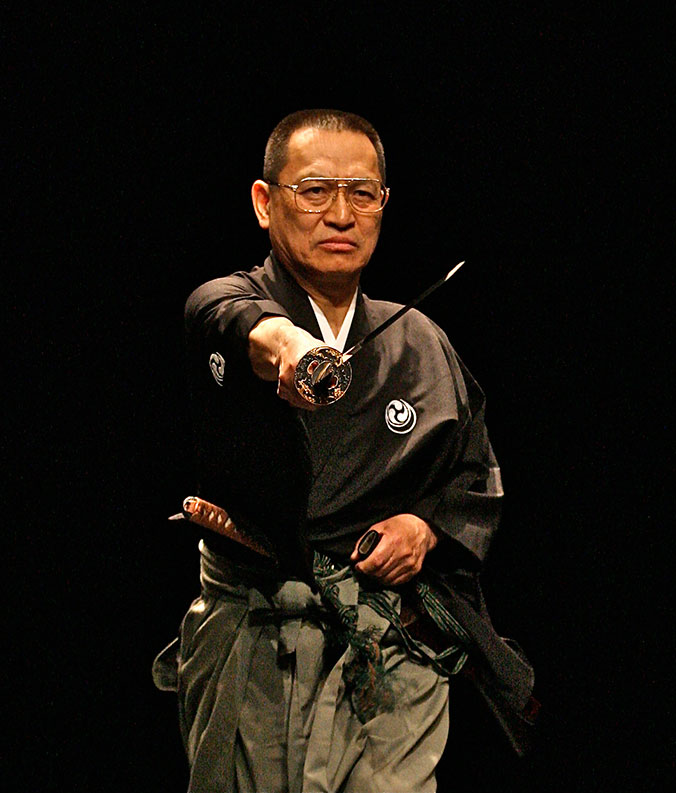
He was the 15th soke of Mugairyu Iaihyodo and held the rank of 9th dan, hanshi (the highest rank and title awarded in Japanese martial arts). He contributed to the diffusion of Mugairyu by becoming a well-known and respected teacher of the art, and he was even active at All Japan Kendo Federation tournaments.
It is said that there are three levels in the budo world, “Shu”, “Ha”, and “Ri”. Most of my students do not progress beyond “shu”, quit training, or escape to other iaido (or even other Mugairyu) groups. While adhering to the fundamentals I learned from Shiokawa sensei, last year (2013) in December shortly before his death, I finally moved past the “ha” stage into “ri”.
I put this in a letter to Shiokawa sensei and later heard that he was deeply moved by my progress. According to his wife, Shiokawa sensei kept that letter under his pillow and read it over and over again.
My sensei entrusted me with many things, and I now lead my own students. I understand how happy my teacher was with my progress and growth now that I am in the same position in charge of my own students. He was a great teacher. I was very fortunate to be close to him and to be able to learn from him.
There was a period when I was training late into the night at his dojo. He told me, “This is my dojo, so use it freely until any time (of the night).” After being taught by him until around 10 o’clock, he would often say, “I’m heading upstairs,” and I would continue training in the dojo. After I had been training a while, he would come back down to the dojo with a beer in his hand and say, “Niina, your feet are wrong.” He hadn’t been watching, so how could he have known? He must have been upstairs listening and realized, “That’s not right!” This really surprised me. I am still grateful for what he has given me and thank him every day.
About my Ryuha (Branch of Mugairyu) and Instruction

Mugairyu is currently known as an iaido style. According to the internet encyclopedia, “Wikipedia”, there are over 60 styles of iaido that are still practiced. The iai being taught among various organizations, even within the same styles of iai, is primarily “kata” (a series of movements or forms performed with a sword) training which is done by oneself.
The only thing relied upon in this case is theory. If theory is all there is, then we can only talk about the “do” in “iaido”. However, someone who truly possesses authentic iai is someone who lives on the border between life and death when the sword is drawn from the saya (the scabbard). There is nothing wastefully decorative about Mugairyu. Most certainly because of this simplicity, one feels “life and death” very closely, which is how I feel.
The first step to learning iai is knowing how to draw and resheath the sword, as well as knowing how to wield it. A primary principle of iai is drawing the sword to cut rapidly, and this is a fact that cannot be overlooked. This means that drawing and resheathing the sword is something that must be practiced thoroughly. Through this refinement, it’s possible to cut makiwara (straw targets used in cutting practice) with ease. At some prior point in history, in a time when iai was actually used by those living on this border between life and death, one’s opponent came charging to kill. Unlike those times, in modern times a straw target won’t come to kill you now.
This first step allows you to understand how easy it is to actually cut. The second step is kumitachi. Unlike the makiwara in the first step, at this stage of training, your opponent will come to strike you. While the sword is still in its sheath, you and your opponent understand each other’s tactics by measuring distance and timing (ma-ai), breathing, as well as tai-sabaki and ashi-sabaki (body and foot movements). You also come to understand that if you act independently of your opponent’s actions you will be cut. After makiwara cutting in step one and kumitachi practice in step two, step three is for kata training on your own.
Training in kata on your own is actually very easy if you don’t think about what you’re doing, but the deeper you dive and the more you know, the more difficult the training becomes. That is the difference between merely “tracing” the kata with movements that clearly cannot cut and amassing the experience from steps one and two so that you are truly taking the first steps into the world of authentic iai.
Additionally, your mental state, in other words the way your mind should be, is also being pursued, which is why Mugairyu is sometimes referred to as “moving zen”. Therefore it is possible to know someone’s technical ability by the way their sword is drawn. Advocating the “do” through simply tracing the kata from the early stages of training will not take us to the same heights as the swordsmen and heroes of the past like the founder of our style.
I think that the sword masters of the past, including the founder of Mugairyu, Tsuji Gettan, attained something from this understanding of life and death through actually knowing how to cut. The “do” that the swordsmen of the past developed was a result of this realization. First they pursued what was useable and strong before finally arriving at their ultimate states (of mastery). For us ordinary people who do not live in a time when life and death are back to back, we can at least learn technique by cutting makiwara and practicing kumitachi, and then, ultimately, all we can do is aim to be “budoka” during our lifetime by seeking out the “do” in kata training through daily practice.
However, the current era is a sad one where it’s possible to just show up to the dojo and nothing more. This is a time when there are a lot of people who sound like they understand what “do” is when they talk about it pompously. But “do” as a concept is not something that is there from the beginning. I think “do” is something that can only be encountered (and understood) after polishing your technique and completing the three stages I spoke of earlier.
“The way is in the technique,” as we say. People who train daily believe in the poem from the Hyakusokuden, “Adhere to the fundamentals, and know that ultimately all will be at peace.” There is nothing more than polishing your own technique to understand your own way in the art.
About Budo
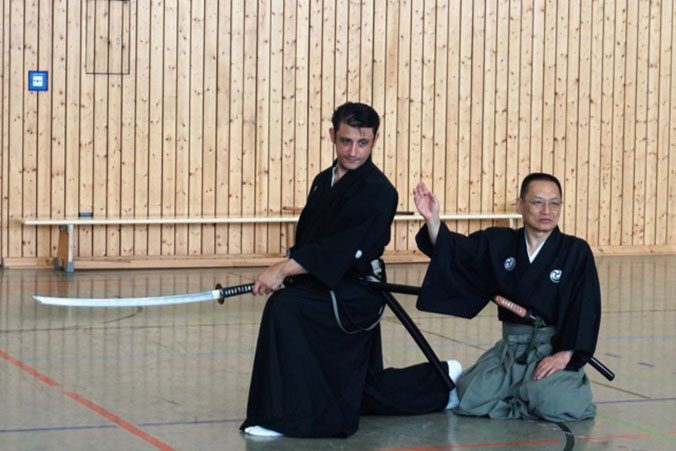
Some people think, “What is budo?” throughout their training. These people train very seriously. They don’t complain about hard training. If they’re warned about something technical, they make note of it and continue to push themselves, first and foremost on a technical level.
After training for 10 years (not simply wasting that time, but actually training), one tends to think that they’ve gotten stronger. The next ten years of devoted training leads to the realization that others are strong as well. Another ten years of training will make you realize your imperfections, weaknesses, and the fact that you don’t know one thing from another. This is the path you will ultimately follow if you train seriously. There is a major pitfall about twelve years after the first ten years of training.
There are a lot of people who mistakenly believe they have gotten stronger about several years after their first ten years of training have passed (whether they have been training seriously or not). Without a doubt, this is nothing more than pride. Regardless of the style of budo, I think there are a lot of people who are conceited. They don’t really have the techniques in their bodies, yet they think they’re better than they really are with what little technique they have and strut around like they already know everything there is to know.
The truth is, however, that there are many strong people in the world and realizing this is the first step on the path of true training. There are many people who realize this but remain easygoing. They never completely exhausted their inquiring mind, and have no need to know if they can defeat (or will be defeated) by those around them. They are in their own world. At last, this is the transition from a “technical” practice to “do”, the path.
Unlike Confucianism, which is widely used in organizations for smooth operations, the “do” in budo training is more akin to Lao-tse’s Taoism.
In budo, comparisons between people over this and that are irrelevant. Your own personal training is never-ending. The founder of Mugairyu, Tsuji Gettan said, “Train for another 30 years”. Menkyo-Kaiden (a full transmission license that indicates someone is completely proficient in all areas of the art, including fundamental techniques, variations, and the deeper teachings, as well as their ability to preserve the art) does not mean the end of training.
Train with the same feeling you had on your first day of training. In doing so, he said, you will always take one step further (on the path). There is a saying that goes, “Learn from one and know up to ten, then return to one.” This saying goes even further….
This is the training inherent in budo, which differs greatly from sports.
I have been training in Mugairyu (and other forms of budo) for many years, but at the same time I have also been researching the origins of Mugairyu in the art known as Yamaguchi-ryu. Around the time that Yamaguchi-ryu was founded (1620), it was two-sword style. As Miyamoto Musashi once said, “If you know how to use both left and right arms efficiently, then having two swords is more advantageous than one sword.” I find this to be an extremely obvious observation.
I have taken Yamaguchi-ryu’s two sword method and have reexamined it to create Genko Nito-ryu, and I am currently offering instruction in this style in North and South America, Europe, Russia, and of course, Japan.
About Bushido

In budo training there needs to be other parts to the training process such as effort, endurance, patience, concentration, and self-control that have transcended the simple physical training. As a result, through definite technical development, you can cultivate confidence and composure, as well as courage, an indomitable spirit, humility, and compassion for others. This is why budo is a never-ending process that aims to complete one’s character and humanity.
Through this strict training, it’s possible to acquire moral character as a human being, as well as the self-awareness, the sense of mission, and thoughtless self-sacrifice which the ruling class that consisted of the “bushi”, or that is to say, leaders, cultivated. The harmony and mental preparedness to fulfill one’s responsibilities after somehow taking in the results of this strict process is what I believe bushido to be.
I think that bushido is a philosophy of action that is practical and includes conduct from the bushi, or “samurai”. This is similar to the noblesse oblige, or chivalry found in the western world. I think these (two cultural similarities) show the existence of a universal system of values. Bushido is an underlying yet pervasive aspect of Japanese culture that still leaves its traces in the hearts of Japanese people. It still constitutes the spiritual backbone of Japanese culture.
The future of Budo
In Nitobe Inazo’s Bushido it is written that bushido will never go away. In today’s global society, it appears that it is thinning out, but in this internationalized society, I think that we have to be able to answer the question, “Who are you?” when going out to confront the world. If asked this question, I think it’s no different than being asked, “Are you Japanese? What does it mean to be Japanese?” After training in budo, if you pursue the behavior included in the direct philosophical actions of the samurai, you will probably think “budo and bushido are amazing!”
People who want to learn budo or deepen their understanding of it are not only Japanese people. There are many people overseas as well. I will teach what I have spent my life pursuing to anyone who wants to learn, regardless of their race, nationality, religion, ideology, or other beliefs. This is my life in budo.



